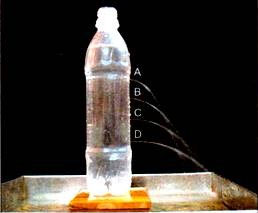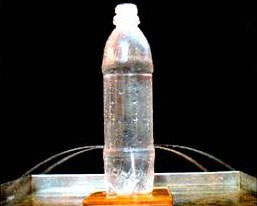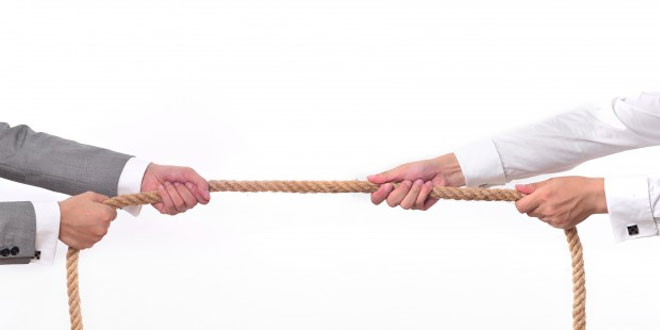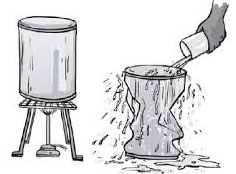Question: What is force? What are the four main effects of force?
Answer: Push or pull is called force. Main effects of force are-
- Force can make stationary object move, or can change its position of rest.
- Force can change the speed of a moving object.
- Force can change the direction of motion of moving object.
- Force can change the shape or size of an object.
Question: What is the difference between Contact and non-contact forces?
Answer: The difference is as follows:
Question: What is friction? Explain with an example.
Answer: Friction is a contact force. Friction is a force that slows things down or prevents things from moving. For example: A ball rolling on the ground slows down and then comes into rest position at a certain distance. The opposing force exerted by the ground on rolling ball is the friction.
Question: Why are caterpillar tracks used in battle tanks instead of tyres?
Answer: Heavy tanks have broad chains called caterpillar tracks which considerably increase area in contact. The tracks help the tanks to distribute its weight more evenly over a larger surface area than wheels can. This prevents its from sinking in areas where wheeled vehicles of the same weight would sink.
Question: How does the pressure exerted by a liquid change with depth? Explain with a diagram.
Answer: Take a plastic container and make four holes in it at different heights. Fill the container with water, and let water keep flowing into it from a tap. Notice the force with which water comes out of the holes.
You will find that water comes out with greater force from the holes at greater depth. Water from the bottom-most hole will be spurted out the farthest from the container. This shows that the pressure in a liquid increases with increasing depth.
Now take another plastic container and make holes all around it at the same depth, by measuring from the top of the container. You will notice that water comes out from all the holes with the same force. This shows that at the same depth, the pressure is the same in all direction.
Question: When you press a rubber sucker on a smooth surface, it sticks to the surface. Expalin why this happens?
Answer: When we press a rubber sucker on a smooth surface, it sticks to the surface. This happens because there is very little air between the sucker and the smooth surface to push from inside. Therefore, the greater atmospheric pressure from outside pushes the sucker firmly to the surface.
Question: Two forces act on an object. Explain what the net force acting on the object will be in different situations.
Answer: The net force acting on the object in different situation will be –
- When forces are applied on an object in the same direction, they add up. The net force on the object is a single force whose magnitude is the sum of the two forces. The net force acts in the same direction as the two forces.
- When forces are applied on an object in opposite directions, they oppose each other. The net force on the object is the difference between the two forces. This net force will act in the direction of the larger force. If two opposing forces are equal, the net force is zero.
Question: Describe an experiment to show that air exerts pressure in all directions.
Answer: Take a plastic bottle. Put some boiling water in it. The steam coming out of the water will expel most of the air from inside the bottle. After about two minutes, screw the cap tightly on the bottle. Put the bottle in a trough and pour some cold water mixed with ice on it. As the bottle cools down and the steam condenses, it has very little air inside it. The atmospheric pressure acting on the bottle from outside, is, therefore much larger than the pressure exerted inside it. This causes the bottle to get crushed from all sides. This experiment shows that air exerts pressure in all directions.
Question: Gravitational force exists between you and a building. Why are you not pulled towards the building?
Answer: The gravitational force is so small that it cannot be felt unless one of the bodies is huge like the earth. The gravitational force between an object and a building is too small to be felt.
Question: Why do you think it is necessary to define a separate quantity called pressure? Why is defining only force not enough?
Answer: To have a clear picture about the capacity of a given force to produce a certain effect, we must not only know the force but also the area over which it acts. Thus, a new physical quantity known as pressure is introduced to find the effect of a force.
Question: Suppose you are going in jet plane, and one of the windows breaks due to an accident. What problems do you think you will face?
Answer: The problems we will face are:
- We will not be able to get enough oxygen from air for breathing because of the low density of air at that height.
- We will experience problems like nose bleeding as the air pressure will be much lower than our blood pressure.
- The temperature at that height will be much below freezing which the body will not be able to tolerate.
Question: If you press a rubber sucker on a rough surface, it does not stick to the surface. why?
Answer: Because there will be many gaps between the rubber sucker and the surface through which air can get in. Some a vaccum will not be developed inside the sucker the it will not stick to the rough surface.
 Class Notes NCERT Solutions for CBSE Students
Class Notes NCERT Solutions for CBSE Students



